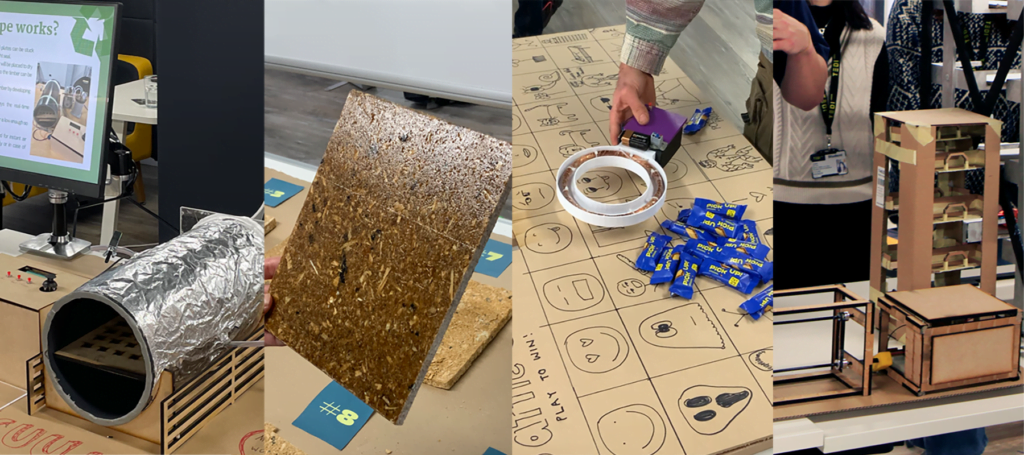
Winter school students showcase urban timber designs

Last week marked the end of our 2024 winter school, during which four student teams designed prototypes for the processing of urban timber. This was to enable industry client YesMake to maximise their efforts in re-using urban timber for public spaces and community projects in London and beyond.
Their time at TEDI-London culminated with a Showcase Day, which gave each team the opportunity to present their ideas and prototypes to their peers, industry partners and TEDI-London staff. Here’s a rundown of the solutions they came up with:
View this post on Instagram
SWIFTRACK BTS
For small businesses working with urban timber, current racking systems can cause problems during processing. They are often inefficient and can be difficult to load and unload. That is why the team behind Swiftrack BTS designed a prototype to make storage systems and racking technology more accessible and efficient for small businesses. Their solution combined traditional timber racking systems with a rotational storage system to create a vertical carousel rack that brings the material to the user, minimising complications associated with existing racking systems. Their product utilises a truss system that allows the shelves to rotate without becoming unbalanced, and businesses can choose between a hand-crank or integrated motor subsystem to rotate the shelves based on what they can afford. The shelves are also made out of cage material to allow the wood to air.
SAWN OFF STRUCTURES
Yes Make often finds that, after processing urban timber, they are left with an excess of wood chips and dust, which they wish they could reuse rather than just discard as waste. The team behind Sawn Off Structures took up the challenge by creating a prototype of a wood board inspired by OSB and MDF timber which aims to be more sustainable than comparative products stemming from the particle board industry. Their product combines wood chips and sawdust with wood adhesives, which is then poured into moulds before applying pressure to it to turn it into a board. At the Showcase, the team showed 10 prototypes to illustrate the results they got based on the ratio of wood chips and adhesives, and on the pressure applied.

POCKET PROBE
When working with urban or second-hand timber, small businesses and DIY enthusiasts often risk damaging their chainsaw blades when hitting against undetected nails or metal shrapnel, which means they need to spend extra energy and time re-sharpening them before they can get back to their project. To solve this issue, the team behind Pocket Probe has created a prototype of a cost-effective and portable metal detector, which can be used on a piece of wood to spot any hidden pieces of metal and prevent unexpected encounters before starting to saw it. To demo how their product worked, the team created a treasure hunt, hiding pieces of metal underneath a wood board. If you could find the pieces using their Pocket Probe prototype, you’d win a snack!
THE VACUUM KILN
Yes Make find that air drying timber can cause a bottleneck in the production process. That is because it is time consuming, causes inconsistent drying, and has limited control over the moisture content, slowing down the whole process and increasing risks of defects in the end product. The team behind The Vacuum Kiln created a prototype of, you guessed it, a vacuum kiln, to speed up the drying process, give more control in the drying process, and ensure more consistent results. A vacuum kiln works by lowering the pressure within a chamber with timber inside, and lowering the boiling point of water, therefore allowing the timber to dry at lower temperatures. Their prototype also had a control system coded on Arduino, which would allow the user to check the temperature and moisture within the kiln, and ultimately shut the system down when it becomes too hot.
Interested in tackling hands-on projects like this one? Apply to study at TEDI-London this September.
More Winter School articles
